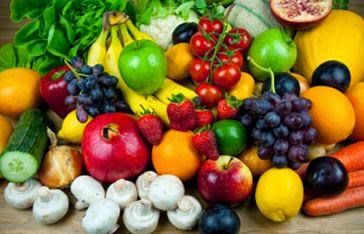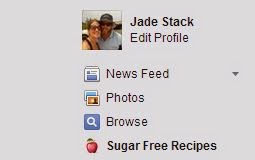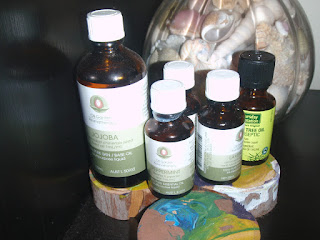The purpose of my blog so far has been to share how I have adopted a very low sugar lifestyle. Refined sugar is no longer part of my life or that of my family’s. For natural sweetness we enjoy fruit and honey with a very rare occasional treat. My kids and I also enjoy the natural sweetness of full fat milk (which is unbelievably sweet after kicking sugar - thanks to lactose) but my husband has decided to stick to low-fat milk.
This blog is not about sugar. It is about my use of homemade cleaning products. When Ruby was born four years ago, it made me think about the use of chemicals in my home. The bathroom always stumped me. I didn't want to clean the bath with chemicals only for me to fill it up that night and have her sit in it. Even though it was thoroughly rinsed, it just didn't sit right with me. This was the turning point for me when I realised that I didn't need chemicals for a clean house.
Four years later, my 'cleaning' cupboard comprises of hardly anything at all as I am now experimenting with making my own. Not only do I have the benefits of now knowing exactly what is being used in my house, but I can also breathe a sigh of relief knowing that it is ok for my children to be in the same environment before, during and after I’m cleaning. To top it off, making my own cleaning products has saved me some cash too, which has been an added bonus.
I have also discovered that the cleaning aisle is just insane - and expensive. We don't need that many cleaning products comprised of that many chemicals - all going down the drain and into our oceans. I use 4 ingredients to do all my cleaning - bi carb soda, soap, washing soda and vinegar. I do add essential oils for scent and antibacterial properties and nothing beats hot water and elbow grease!
Cheap, Safe and Environmentally friendly = win win win!
Five basic ingredients - coconut oil (for toothpaste), bi carb soda, washing soda, soap and vinegar. I use these (in conjunction with some essential oils) to make
Toothpaste
Laundry powder
Dish liquid
Hand soap
Floor cleaner
Multipurpose spray
Mirror/glass cleaner
Bathroom cleaner
Toilet cleaner
Moisturiser
I buy the bi-carb, washing soda and white vinegar in Coles. I also buy the lux flakes there but have realised it would be cheaper buying the bar soap and grating it myself. Don't stick bar soap in your food processor - it killed mine :( Woolworths don't sell bi-carb in 1kg boxes and neither do IGA, which is why I get it in Coles. The Castile Liquid soap I bought at Forest Glen Health food Store for $19.95 for 1L (it goes along way). You can buy liquid Castile soap in Health food stores or online.
$20 for 1L from Forest Glen Health food Store
My coconut oil with the melon scoop
Optional: Essential Oils (Lavender, Peppermint ($14 small bottle), Vegetable Glycerin ($6 bottle from health food stores).
Some of my essential oils - a little goes a long way
The zest and juice of a lemon, lime and orange can also be used in these products instead of essential oil.
All you really need to invest is your time.
Toothpaste
TIME TO MAKE: 5 mins
INGREDIENTS
Coconut Oil (antibacterial properties for your mouth and your bristles)
Bi-Carb soda (whitening, stain removal, freshens breath)
Optional:
Peppermint Essential Oil (for scent & taste)
Vegetable Glycerin (naturally sweet but wont contribute to tooth decay, also makes it smoother and softer in Winter)
METHOD
Mix coconut oil and bi-carb until you have a consistency you are happy with (try 1 part coconut oil to 2 parts bi carb). Optional: Add 5 – 20 drops of Peppermint Essential Oil and a splash of vegetable glycerin.
Our toothpaste dish & scoop
EXTRA INFO
This toothpaste does not bubble or froth like commercial pastes. I have learnt over time that cleaning products do not need to bubble or froth to be doing their job. This applies to a range of homemade cleaning products including this toothpaste.
THIS TOOTHPASTE CHANGES DEPENDING ON THE WEATHER
In warmer weather, this toothpaste will be runny as the coconut oil melts. In colder climates, this toothpaste will be firm as the coconut oil solidifies. The vegetable glycerin will help make it softer during this time. I have mine in a small dish with a paddle pop stick for a scoop.
NOTES FOR THOSE WITH KIDS
Initially, I made a separate one for my daughter decorating her dish with Dora stickers and adding some ‘normal’ toothpaste to help her adjust. With every batch I made, I decreased the amount of ‘normal toothpaste. Months later she now uses the same toothpaste as us from the same dish.
Laundry Powder
TIME TO MAKE: 5 minutes
INGREDIENTS
Bi-Carb soda (brightens, whiten and remove odour)
Washing Soda (softens water)
Soap -flakes, liquid or grated (cleaning power)
Optional:
Lavender or Tea Tree Essential Oil (scent & antibacterial)
Use Vinegar as a fabric softener. It will not leave a scent!
METHOD
Mix equal parts of bi-carb, washing soda and soap in a container. Use ¼ cup for each load. Add more bi-carb to a load of delicate items, more washing soda will clean more.
My laundry powder - you can see the soap flakes
EXTRA INFO
If you have any leftover laundry powders at home, you can add this to your mix.
Do not put vinegar in with your mix, it will bubble and go hard and you'll need to put it in your processor to convert it back to a powder.
I am VERY impressed with this mix. It has removed stains and my clothes come out of the wash so soft!
Dish Liquid
TIME TO MAKE: 10 mins
INGREDIENTS
¼ cup Soap (liquid is better) (cleaning agent)
2 tbsp Vinegar (grease cutting)
2 tbsp Washing Soda (soften water)
1 ½ cups Water
Optional:
Essential Oils: Tea tree (antibacterial), Lemon or lavender for scent.
METHOD
Dissolved flaked or grated soap in hot water on stove – DO NOT BOIL. Add vinegar and washing soda.
OR
Mix liquid soap with water, slowly heat up but do not let it boil, add vinegar and washing soda.
Let mix naturally cool. Store in an old dish liquid container or squeeze bottle.
EXTRA INFO
Like the toothpaste, this dish liquid won’t bubble up like commercial detergents.
If you use grated soap or lux flakes, your detergent may go hard. In this case, I just use a melon scoop to put it in sink. I do prefer the liquid version so I now use liquid castile soap to make mine so that I don't have to worry about it going hard.
Although this works and I am happy with it. I'm still looking for a better one that will cut through the grease a bit better. This is my starting point. Will keep you updated.
Hand Soap
TIME TO MAKE 5 mins
IINGREDIENTS
¼ cup Soap (cleaning)
Water
Optional:
Essential Oil (scent)
METHOD
Dissolved flakes or grated soap in hot water. Add essential oil for scent.
OR
Liquid castile soap can be added directly to warm water, shake to mix. Add essential oil for scent.
EXTRA INFO
If you use grated soap or lux flakes, your hand soap may go hard; in this case, add more water or vegetable glycerin or oil. Using liquid castile soap assures a liquid product at the end.
Adding coconut oil, Vitamin E, jojoba oil or other oils will give your hand soap a moisturising property and help keep in liquid form. Remember that coconut oil solidifies when cold.
Floor Cleaner (tiles/vinyl)
I don't 'store' this in a bottle, I just make it up when I mop the floors.
TIME TO MAKE: <5mins
INGREDIENTS
1 cup vinegar (cleaning, grease cutting)
1/4 cup liquid castile soap
Hot Water
Optional:
Essential Oil (scent/antibacterial)
METHOD
Mix one cup of vinegar and 1/4 cup castile soap in your mop bucket and fill will hot water. Add essential oil for scent and/or antibacterial agent.
EXTRA INFO
This is soooooooooooooooooooo easy and I haven’t had any problems at all with cleaning my floors. William can also crawl straight onto it, even if it is wet and I don’t have to worry. No vinegar scent is left.
A TIP PASSED ON FROM A FRIEND
My friend Jo, who is a mother of four boys, told me years ago how she adds lavender oil to her mop bucket for a ‘calming’ effect on the house. I’ve done this ever since. Citronella will help keep bugs at bay, peppermint will give you an uplifting atmosphere, and lemon is great when there are colds or flus in the house. The list is endless!
Multi Purpose Spray – benches, cupboard doors etc
TIME TO MAKE: 5 mins
INGREDIENTS
1 Tb sp Bi carb (mild abrasive scrub)
1 Tb sp Vinegar (grease cutting)
1 Tb sp Soap (cleaning)
Water
Optional:
Essential Oil (scent / anti bacterial)
METHOD
Dissolved soap and bi carb in a little bit of water (shake in cold water or heat in warm water). Once dissolved add vinegar and fill remaining bottle with water. Add essential oil for scent.
Mirror/Glass Cleaner
TIME TO MAKE: 2 mins
INGREDIENTS
Vinegar
METHOD
Spray vinegar directly on glass and mirrors and clean with newspaper
Vinegar: Weed killer & window/glass cleaner
EXTRA INFO
Use this spray as a weed killer. Spray directly on weeds in dry weather. Salt can also be used as a weed killer.
Bathroom cleaner - crème cleanser (as the shops will call it!)
TIME TO MAKE: 5 min
INGREDIENTS
Bi-carb (abrasive cleaner)
Water
Optional:
Add essential oil for scent or jojoba oil for extra softness
METHOD
Mix bi-carb with water (or you can mix with shampoo, liquid soap, condition - whatever you have in the shower) and scrub away! I use this for my shower/bath, basin, toilet seat etc and just rinse off.
Toilet cleaner
TIME TO MAKE: 5 min
INGREDIENTS
Bi-carb (abrasive cleaner)
Vinegar
Optional:
Add essential oil for scent or jojoba oil for extra softness
METHOD
Tip bi-carb into toilet - Add vinegar and it will explode like a volcano - scrub toilet. To remove hard water stains from the bottom of your toilet turn off the water at the back, flush the toilet and you will have water left at the bottom of the toilet. This stops sewer fumes from coming back up the pipes. Scoop water out with container or use a syphon hose (as I do) to syphon water out. Leave bi-carb and vinegar mix in the bottom for 30 minutes then scrub with toilet brush.
Moisturizer
TIME TO MAKE: instant
INGREDIENTS
Coconut Oil (antibacterial, moisturising)
Optional:
Add essential oil for scent or jojoba oil for extra softness
METHOD
Apply directly to skin for an instant moisturiser. I use this everyday from top to toe. I have a separate jar of coconut oil in the bathroom for beauty use. I also have a container next to Williams change table for nappy changing only. After steaming up the bathroom with a hot shower, the coconut oil on the basin is always nice and soft straight after my shower.
This is the coconut oil I keep in the bathroom
EXTRA INFO
Pure Coconut Oil is the most powerful item in my house. It can be used for 100’s of things both in cooking, cleaning and beauty. The benefits are far too many to list or name.
I have a jar next to my stove and as it goes very hard in Winter, I use a melon baller to scoop it out. I just leave the melon baller in there. It works a treat. When I need to top it up, I sit my 5L tub of coconut oil in the bath with the kids, so that it will turn into a liquid and I can top up my jars.
I also use PURE unrefined cold pressed coconut oil for….
· Eye makeup removal
· Lip balm
· Limit frizz in my hair!
· Cuts, abrasions, fungal infections
· Baby lotion for William
· As a nappy cream – anti fungal when he has a red bum
· Massage oil (add lavender to it) - great for massaging William
· Cradle cap
· I use it as an all round moisturiser from head to toe
· Leave in condition – put on dry hair, put shower cap on, leave for 30-60minutes. Wash out.
· Add to a bath for a moisturiser
· Deodorant – rub under arms or use in spray bottle when it’s a liquid (can mix with bi-carb too)
I cannot talk enough about coconut oil. Its natural powerful properties are like no other. If I’m going on holidays I never leave without a jar of it, It will solve any problems while we’re away both for myself, my husband, my 4 year old and 1 year old. It melts when at a temperature of more than 17°C and solidifies when less than 17°C.
This stuff can do EVERYTHING!!!
Next time….
I hope that you have enjoyed this blog and will have a go at making something. If any of these recipes don’t suit you or you’re not happy with them, simply use Google to find lots of other recipes and variations. I am looking forward to blogging soon with some other products that I make for around the home including insect repellent and a natural pesticide for the garden. I’ll also be sharing my findings on some beauty recipes I'm playing with like lip balm and soap.
Remember, to save extra money and help the environment keep old containers, jars and bottles as they will come in handy when storing your new products and ingredients. Remember to remove all old labels and clearly label with new contents to avoid accidents.
 For me, fat is a huge part of my diet. It has been ever since I started this 'sugar-free' journey, especially after reading "Eat Fat, Lose Fat" by Dr Mary Enig and Sally Fallon (authors of the nourishing traditions - another GREAT book). David Gillespie and Sarah Wilson are obviously two well known advocates for eating good fats and their websites, blogs and books are a wealth of knowledge.
For me, fat is a huge part of my diet. It has been ever since I started this 'sugar-free' journey, especially after reading "Eat Fat, Lose Fat" by Dr Mary Enig and Sally Fallon (authors of the nourishing traditions - another GREAT book). David Gillespie and Sarah Wilson are obviously two well known advocates for eating good fats and their websites, blogs and books are a wealth of knowledge.






























